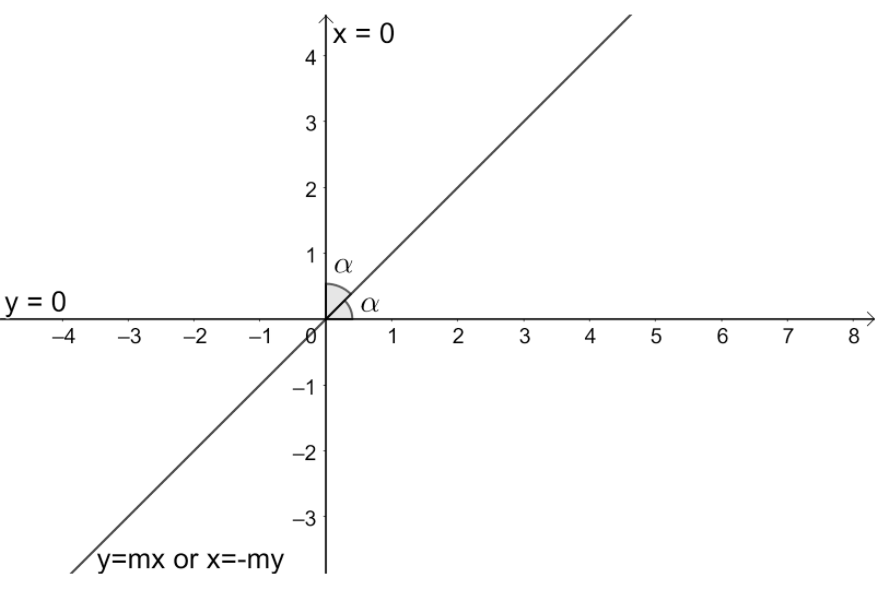
If one of the lines of $m{{y}^{2}}+\left( 1-{{m}^{2}} \right)xy-m{{x}^{2}}=0$ is a bisector of the angle between the line $xy=0$, then find the value of m?
(a) -2
(b) 1
(c) 2
(d) $\dfrac{-1}{2}$
Answer
565.8k+ views
Hint: We start solving the problem by finding the equation of lines present on the pairs of lines $m{{y}^{2}}+\left( 1-{{m}^{2}} \right)xy-m{{x}^{2}}=0$ and $xy=0$. We then find the angle between the lines present in $xy=0$ and find the slope of the line required to bisect the lines present in $xy=0$. We then equate this slope with the slopes of the lines present in $m{{y}^{2}}+\left( 1-{{m}^{2}} \right)xy-m{{x}^{2}}=0$ to get the required values of m.
Complete step-by-step solution
According to the problem, we are given that one of the lines of $m{{y}^{2}}+\left( 1-{{m}^{2}} \right)xy-m{{x}^{2}}=0$ is a bisector of the angle between the line $xy=0$.
Let us first find the lines present in the pair of lines $m{{y}^{2}}+\left( 1-{{m}^{2}} \right)xy-m{{x}^{2}}=0$.
So, we get $m{{y}^{2}}+xy-{{m}^{2}}xy-m{{x}^{2}}=0$.
$\Rightarrow y\left( my+x \right)-mx\left( my+x \right)=0$.
$\Rightarrow \left( y-mx \right)\left( my+x \right)=0$.
$\Rightarrow y-mx=0$ and $my+x=0$.
$\Rightarrow y=mx$ and $x=-my$ ---(1).
Now, let us find the lines present in the pair of lines \[xy=0\].
So, we get $x=0$ and $y=0$. We know that this represents both axes and the angle between them is ${{90}^{\circ }}$. In order to bisect both axes we need the lines that make ${{45}^{\circ }}$ with both x and y axes (assuming that the line bisects both axes in the first quadrant only).
So, the slope of the line should be $\tan \left( {{45}^{\circ }} \right)=1$.
Let us draw all the obtained information to get a better view.

Let us assume that the line $y=mx$ is the bisector of lines $x=0$ and $y=0$. We know that the slope of the $y=mx+c$ is m. So, we get the value of m as 1 i.e., $m=1$ ---(2).
Now, let us assume that the line $x=-my$ is the bisector of lines $x=0$ and $y=0$.
So, we get $y=\dfrac{-1}{m}x$.
We know that the slope of the $y=mx+c$ is m.
So, we get the $\dfrac{-1}{m}=1$.
$\Rightarrow m=-1$ ---(3).
From equations (2) and (3), we have found that the values for “m” are 1 and –1.
∴ The correct option for the given problem is (b).
Note: We should know that the line making ${{135}^{\circ }}$ with x-axis will also bisect both x and y-axes but here we have taken an assumption that the angles lie in the first quadrant. Even if we take the slope of the line at the angle ${{135}^{\circ }}$, we get the same values for “m”. We should not make calculation mistakes while solving this problem. Similarly, we can expect problems to find the equation of the line that makes a triangle of area b which is formed when the line bisects both axes.
Complete step-by-step solution
According to the problem, we are given that one of the lines of $m{{y}^{2}}+\left( 1-{{m}^{2}} \right)xy-m{{x}^{2}}=0$ is a bisector of the angle between the line $xy=0$.
Let us first find the lines present in the pair of lines $m{{y}^{2}}+\left( 1-{{m}^{2}} \right)xy-m{{x}^{2}}=0$.
So, we get $m{{y}^{2}}+xy-{{m}^{2}}xy-m{{x}^{2}}=0$.
$\Rightarrow y\left( my+x \right)-mx\left( my+x \right)=0$.
$\Rightarrow \left( y-mx \right)\left( my+x \right)=0$.
$\Rightarrow y-mx=0$ and $my+x=0$.
$\Rightarrow y=mx$ and $x=-my$ ---(1).
Now, let us find the lines present in the pair of lines \[xy=0\].
So, we get $x=0$ and $y=0$. We know that this represents both axes and the angle between them is ${{90}^{\circ }}$. In order to bisect both axes we need the lines that make ${{45}^{\circ }}$ with both x and y axes (assuming that the line bisects both axes in the first quadrant only).
So, the slope of the line should be $\tan \left( {{45}^{\circ }} \right)=1$.
Let us draw all the obtained information to get a better view.

Let us assume that the line $y=mx$ is the bisector of lines $x=0$ and $y=0$. We know that the slope of the $y=mx+c$ is m. So, we get the value of m as 1 i.e., $m=1$ ---(2).
Now, let us assume that the line $x=-my$ is the bisector of lines $x=0$ and $y=0$.
So, we get $y=\dfrac{-1}{m}x$.
We know that the slope of the $y=mx+c$ is m.
So, we get the $\dfrac{-1}{m}=1$.
$\Rightarrow m=-1$ ---(3).
From equations (2) and (3), we have found that the values for “m” are 1 and –1.
∴ The correct option for the given problem is (b).
Note: We should know that the line making ${{135}^{\circ }}$ with x-axis will also bisect both x and y-axes but here we have taken an assumption that the angles lie in the first quadrant. Even if we take the slope of the line at the angle ${{135}^{\circ }}$, we get the same values for “m”. We should not make calculation mistakes while solving this problem. Similarly, we can expect problems to find the equation of the line that makes a triangle of area b which is formed when the line bisects both axes.
Recently Updated Pages
Master Class 11 Business Studies: Engaging Questions & Answers for Success

Master Class 11 Computer Science: Engaging Questions & Answers for Success

Master Class 11 Maths: Engaging Questions & Answers for Success

Master Class 11 Chemistry: Engaging Questions & Answers for Success

Master Class 11 Economics: Engaging Questions & Answers for Success

Master Class 11 Accountancy: Engaging Questions & Answers for Success

Trending doubts
What is meant by exothermic and endothermic reactions class 11 chemistry CBSE

10 examples of friction in our daily life

One Metric ton is equal to kg A 10000 B 1000 C 100 class 11 physics CBSE

1 Quintal is equal to a 110 kg b 10 kg c 100kg d 1000 class 11 physics CBSE

Difference Between Prokaryotic Cells and Eukaryotic Cells

What are Quantum numbers Explain the quantum number class 11 chemistry CBSE




